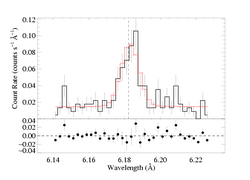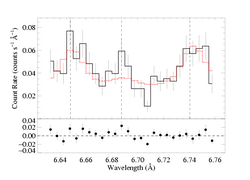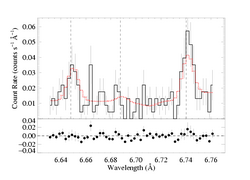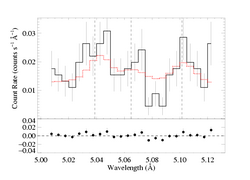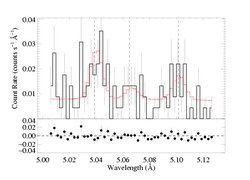Emission lines
Analysis of the entire 94 ks observation
Note that "+/-" uncertainties are actually 68% confidence ranges for the specified parameters.
Si XIV Lyα
We use an emissivity-weighted mean wavelength of 6.1822 A for the Lyman-alpha doublet of H-like silicon. We fit the MEG (top) and HEG (bottom) with wgauss + pow:
Si XIII Heα
He-like complexes - resonance, intercombination, forbidden lines - in the MEG (top) and HEG (bottom) panels, fit with hegauss + pow:
S XVI Lyα
We use an emissivity-weighted mean wavelength of 4.731 A for the Lyman-alpha doublet of H-like sulfur. We fit the MEG (top) and HEG (bottom) with wgauss + pow:
S XV Heα
He-like complexes - resonance, intercombination, forbidden lines - in the MEG (top) and HEG (bottom) panels, fit with hegauss + pow:
Summary of line ratios
Si XIV/XIII = 1.50+.33-.28
Si XIII R = f/i = 5.40-2.2 while Ro=2.3
S XVI/XV = 0.55+.26-.18
S XV R = f/i = 1.90+2.28-.82 while Ro=2.0
These ratios can be compared to models (temperature for Lyα/Heα and density for R = f/i). And we could also divide up the data into pre-flare, flare, and post-flare intervals and look for statistically significant changes in the line ratios. Thus far, we have only done this for the Fe K-shell lines seen in the HEG spectrum:
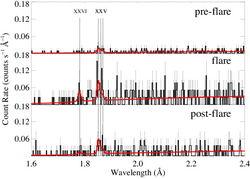
Line ratio modeling: R values for the He-like features
Both the Si XIII and the S XV R=f/i are consistent with the low-density limit. Because the Si XIII f/i ratio has the lower critical density, this feature provides the stronger constraint of the two.
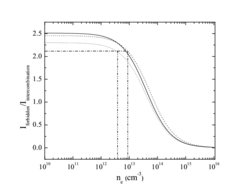
Si XIII: 95% lower confidence bound on f/i is shown as a dash-dotted line, corresponding to a range of densities (4 to 9 X 1012 cm-3), depending on the choice of model (solid is Blumenthal, Drake, & Tucker 1972; dotted is Porquet & Dubau 2001; and dashed is PrismSpect (MacFarlane et al., 2004)).
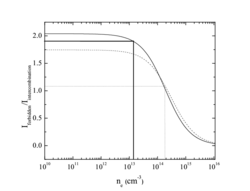
S XV: best-fit f/i is shown as the solid horizontal line. The 68% lower confidence bound is shown as the dotted line.
Back to the main page.
last modified: 3 May 2009

